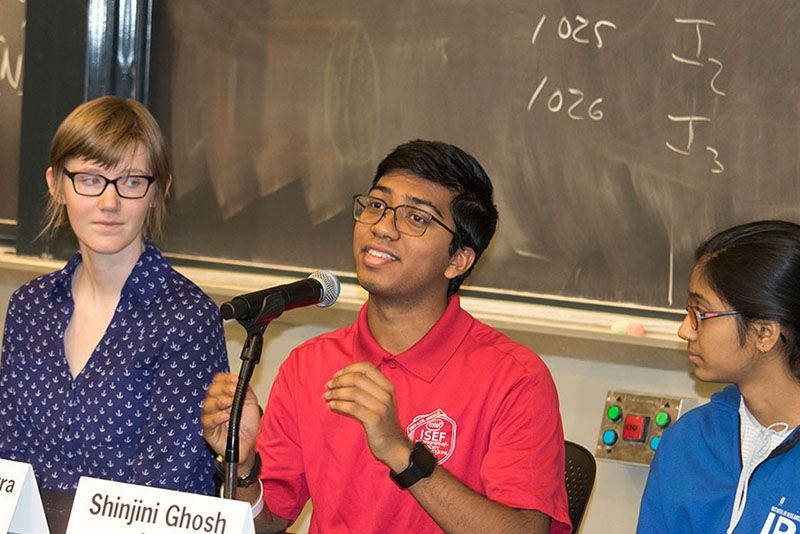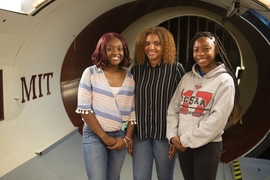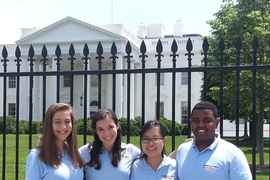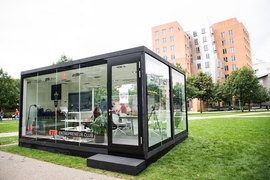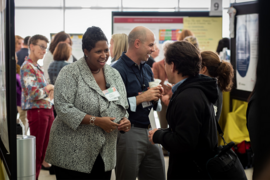Amid rain, midterms, and the World Series, the Edgerton Center and MIT Admissions recently co-sponsored the screening of “Science Fair,” a National Geographic documentary film that follows nine high school students on their journey to compete in the 2017 Intel International Science and Engineering Fair (ISEF).
Hailed as an “ode to the teenage science geeks on whom our future depends,” the film follows the lives of nine students on their journey to the Intel ISEF in Los Angeles, where 1,700 teenage finalists from 78 countries competed for first prize.
Following the screening, a panel of five MIT students and ISEF alumni — first years Madison Sneve, Syamantak Payra, and Shinjini Ghosh and sophmores Afeefah Khazi-Syed, Ruiwen “Doris” Fu — along with ISEF judge, past competitor, and Harvard University Associate Professor Scott Kominers, discussed the far-reaching impacts that science fairs have had on their lives.
Moderated by Senior Assistant Director of Admissions Chris Peterson, each panelist agreed that participating in science fairs helped them find their community, dive into creative scientific research, and for some, seriously consider applying MIT.
In India, where Ghosh grew up, science fairs are not nearly as popular as they are in the U.S. The recognition she received at the 2017 Intel ISEF for developing a language identification kit propelled Ghosh to apply to MIT and made the Institute seem like a real possibility for her.
Khazi-Syed did her first mandatory science fair in 5th grade. “Starting from that age I liked the idea of experiments and testing things and getting your hands dirty,” she said.
From grade 1 on, Payra said he has conducted experiments and has “been doing science fairs every single year from 1st grade to 12th.”
Participating in science fairs was mandatory for Sneve, who attended Dupont Manual High School in Louisville, Kentucky, one of the high schools featured in the film that sent four participants to ISEF.
“Before doing research I knew I wanted to go into a science career but I had no idea what that meant in the practical sense. Without actually doing research, it’s hard to tell what that’s like, the ups and downs and if you’ll enjoy it or not. Being able to do it at high school told me how much I liked the process and how much I want to do it in the future,” Sneve remarked.
Getting to the Intel ISEF was admittedly stressful for Sneve. “There was a lot of cutthroat competition, but being able to present to professors and my peers made me feel like I was a real scientist,” she said.
For Fu, who had arrived in the U.S. from China in 9th grade, science fairs forced her to quickly find her voice.
“Doing science fair really forced me to speak and communicate,” said Fu, who appears in the film as part of the Jericho High School contingent with a science teacher of Herculean force, Serena McCalla. “I was very shy, didn’t have a lot of friends, didn’t speak in class. I had to talk to a lot of people, [and] present posters to judges in competitions.”
Khazi-Syed, who was raised by orthodox immigrant parents, identified with Kashfia, the Muslim girl portrayed in the film. Kasfhia recruited the football coach as her faculty mentor in a school where science is not nearly as valued as sports.
“I never expected to go to ISEF,” said Khazi-Syed. “It was an introduction to this whole world of science and engineering and it showed me what was out there. Before then, coming to MIT was never on the table. Figuring out what all was out there was the biggest takeaway.”
Another takeaway, she said, “was the friends I had, the people I got to talk to.”
Payra saw the science fair as not just as a place to compete but as a place to pursue a project that he was passionate about.
“Some of my projects in my junior and senior years took maybe 800 to 900 hours, the amount of failure and work that goes into that at every single step is really a ginormous amount,” Payra said.
Kominers, who serves as co-chair of the Grand Award judge for mathematics and is on the non-profit organization that runs ISEF, the Society for Science and the Public, commented on the growing expertise of research.
“We are always blown away by the students, but the projects get better every year, they’ve completely transformed,” he said. “We [the judges] see this graduate level stuff and we go 'Wow I’m not sure I could have done that in graduate school.'”
"The beauty of research is the chance for students to pursue questions that have not been answered before," says Ian A. Waitz, vice chancellor for undergraduate and graduate education. “Science fairs, at their best, provide a means for future scholars to connect, learn from one another, and gain the kinds of skills and thought processes that will serve them at places like MIT or just about anywhere they end up.”


